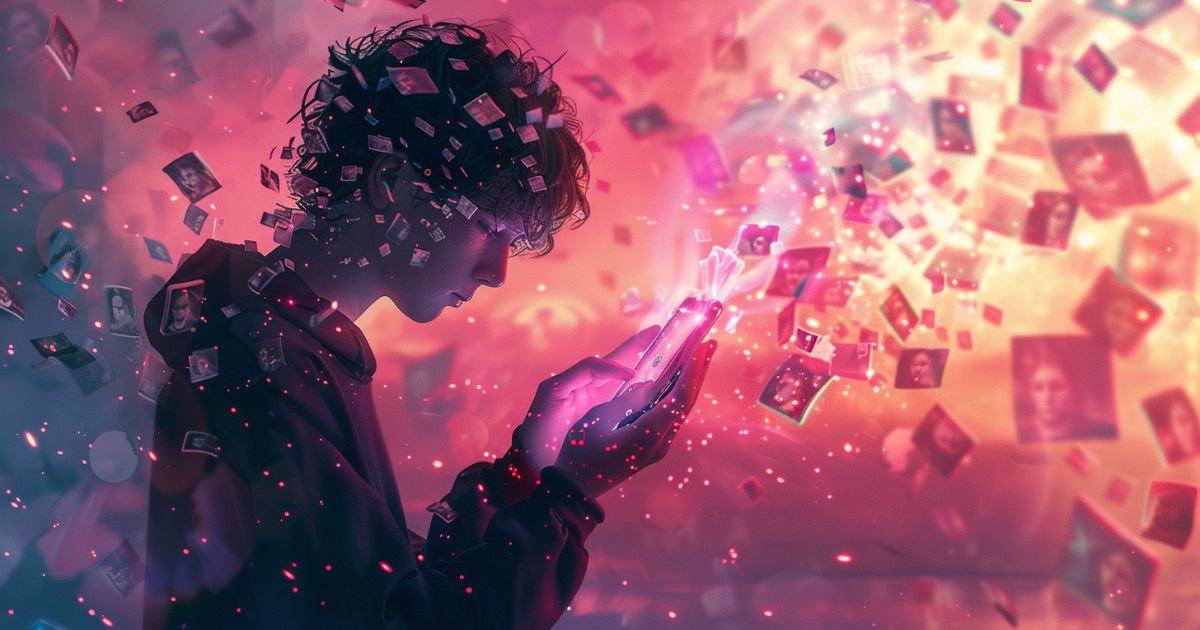Psychology Classics On Amazon

The Gen Z Stare: Where a Blank Face Meets Modern Psychology

“I just had my first experience with the Gen Z stare.”
Those words open the short YouTube montage embedded below - a rapid mix of TikTok reactions, millennial impressions, and a clip from The White Lotus in which a guest meets an uncanny silence. In the video, Gen Z content creator Jet Demetrius Laam describes the look as a deadpan reply to awkward customer questions, while older commentators typically call it unsettling or rude.
I realised I’d seen the same expression a few weeks earlier, when a young person fixed me with that steady, unblinking gaze during a bit of small talk. I assumed I was boring them and quickly forgot about it, that is, until a post on the Gen Z stare popped up in my Facebook feed. The memory resurfaced, along with a flood of questions: What sparks this blank look? Why does it provoke such strong reactions across age lines? And what, if anything, does psychology say about its deeper meaning?
What is the Gen Z stare?
Social media defines the stare as a long, expression‑neutral look - wide eyes, slack jaw, little to no vocal response - that shows up in service encounters, Zoom meetings, or even phone calls. The term exploded after TikTok compilations in mid‑2025 and was quickly dissected by outlets such as Forbes and NPR.
Are we replaying an old generational story?
Every cohort eventually becomes a target of moral panic. Gen X were branded “slackers,” millennials “entitled,” and now Gen Z are deemed “expressionless.” It appears that these generational stereotype cycles repeat roughly every 20 years, as older adults judge the newest adults by the standards they were taught.
This is why psychologists caution that the Gen Z stare should not be viewed as part of a clinical diagnosis; it is simply a folk term stitched together from viral anecdotes. Calling it a syndrome, for example, risks turning everyday communication glitches into pathology. No manual lists criteria for a “stare disorder.” Instead, the phrase serves as modern shorthand for a communication quirk that feels new to older adults.
Two culture shocks that may explain the Gen Z stare
1. Life through a lens
Today’s teens and emerging adults spend staggering amounts of time in front of cameras. An APA Monitor story notes that more than one‑third of American teenagers report five or more hours per day on social media alone. That figure does not include gaming, streaming, or homework on screen. Heavy exposure is linked to weaker face‑to‑face emotion skills and fewer spontaneous smiles. Automated‑facial‑coding studies show that adolescents who monitor their own image for hours curate a “rest‑neutral” pose so an unexpected freeze‑frame will not look awkward.
Separate laboratory work on spontaneous facial mimicry finds that real‑time video chats suppress the tiny muscle twitches that normally mirror a partner’s expression. A 2023 EMG validation study recorded diminished zygomatic activity (the smiling muscle) among frequent video callers, reinforcing the idea that heavy screen use trains neutrality.
2. The mask years
During the pandemic, children learned to read emotion almost entirely from the eyes. A 2024 Frontiers in Psychology study followed preschoolers through a full year of mandatory masking and found significant improvement in recognising both happiness and sadness when only the upper face was visible. When masks came off, many students kept the old habit of holding the lower face still, especially when they felt uncertain. For a generation that hit puberty during lockdowns, a flat mouth is simply the baseline.
Self‑objectification: turning people into pictures
Scrolling through thousands of faces each day can blur the line between a living person and a digital image. A three‑level meta‑analysis of 68 studies confirmed that heavier social‑media use predicts higher self‑objectification, meaning users come to view their bodies as objects displayed for others. When you regard yourself as a static thumbnail, it makes sense to minimise uncontrolled expressions. The same habit can seep into offline interactions: other people become images to scan rather than partners to engage, so there is less impulse to animate your own features.

Anxiety, authenticity, and new display rules
Anxiety is surging among young people. A Frontiers in Psychiatry analysis shows that anxiety‑disorder rates in 10‑ to 24‑year‑olds have climbed 52 percent since 1990. When your nervous system is already on high alert, showing emotion can feel risky. In a recent Event-related potentials (ERP) experiment, participants with high social anxiety poured extra brainpower into decoding other people’s smiles yet suppressed their own facial‑muscle activity during the key attention window. Staying neutral, the researchers conclude, conserves emotional energy and lowers the odds of looking foolish.
Add to that a social‑media ecosystem obsessed with “being real.” Teens often report that they’d rather look reserved than flash a smile they don’t feel; it would appear that in Gen Z land, nothing is more cringe than forced enthusiasm. The net result being a poker‑face norm that older generations read as disengaged, even though it’s more likely just a self‑protection response in a hyper‑connected world.
Costs and benefits for Gen Z
Possible upsides
- Energy conservation. A mild, neutral face drains less emotional fuel during long shifts.
- Boundary‑setting. The stare can be employed to facilitate “grey‑rocking” in order to deflect rude customers without confrontation.
- Digital alignment. The look matches how Zoomers express nuance with emoji or response‑time cues.
Potential downsides
- Misread signals can derail job interviews or teamwork.
- Emotional suppression may reinforce avoidance cycles in anxious individuals.
- People who crave warmth may withdraw, shrinking social networks
Practical tips for bridging the gap
For Gen Z readers
1. Record a short conversation on your phone, then play it back with sound off. Notice what your face communicates and experiment with a nod, a half‑smile, or raised eyebrows.
2. When a pause feels awkward, narrate it: Give me a second to think about that. This keeps silence from reading as stonewalling.
3. Treat small social risks as practice. A quick “Morning, how are you?” warms the air with minimal effort.
For parents, teachers, and managers
1. Model clear micro‑expressions. A relaxed smile at the start of a meeting sets the tone that neutral listeners can mirror.
2. Give explicit, private feedback. Many young employees do not realise their default face seems icy.
3. Translate digital cues into live ones. If a thumbs‑up emoji signals agreement online, teach that a slight head nod can serve the same purpose in person.
4. Address anxiety directly. Offer mental‑health resources instead of labelling silence as laziness.
5. Make sure you read the American Psychological Association (APA) Health advisory on social media use in adolescence.
Frequently asked questions
Is the Gen Z stare deliberate?
Usually not. Most teens are unaware of doing it until someone tells them.
Does it mean disrespect?
A blank look is often employed to protect the starrer, rather than to offend the viewer. The chill we feel can stem from our own rejection sensitivity.
Will Gen Z grow out of it?
Expressive range should broaden, particularly with workplace experience, as such, it is likely that Gen Z will eventually shed the stare label.
Conclusion
The Gen Z stare is not evidence of moral decline. It is a complex adaptation to pervasive cameras, pandemic masking, rising anxiety, and new rules about authenticity. Reading that context turns irritation into empathy. Add a touch of warmth on both sides and silence becomes conversation.
History shows that every generation’s quirks have sparked moral panic in their elders, and the 1790 lament below proves the Gen Z stare is simply the latest chapter in a very old story.
“The free access which many young people have to romances, novels, and plays has poisoned the mind and corrupted the morals of many a promising youth.”
— Reverend Enos Hitchcock, 1790
Know someone who would be interested in reading
The Gen Z Stare: Where a Blank Face Meets Modern Psychology
.
Share This Page With Them.
Go From "
The Gen Z Stare: Where a Blank Face Meets Modern Psychology
" Back To The Home Page